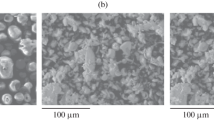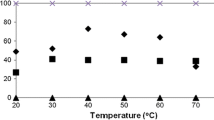Abstract
Solvents have an important effect on the epoxidation of propylene catalyzed by TS-1. The experimental results show that, in different solvents, the catalytic activity of epoxidation is in the following order: methanol > 2-propanol > 2-butanol > acetonitrile > acetone > tetrahydrofuran. Based on the reaction mechanism, the effects of solvents on the epoxidation were studied from eight aspects, which included the electronic effect, the steric effect, the polarity of solvent, the effect of solvent on sorption and diffusion of reactant, the oxidation of alcohol, the etherification of PO, the deactivation of TS-1 and the solubility of propylene in the solvents. The electronic effect, steric effect and the polarity of solvent were considered to be the main aspects. This work may provide theoretical guidance for choosing solvents for these kinds of reactions and also may serve as basis for further industrialization.
Similar content being viewed by others

References
Wu Yulong, Wang Chunyan, Zhang Xiangwen, Mi Zhentao. Study progress in integrated process of epoxidation of propylene catalyzed by TS-1 and production of H2O2. Chemistry Online, 2000, (13): 00108 (in Chinese)
Liu Xuewu, Wang Xiangsheng, Guo Xinwen, Li Gang. Effect of solvent on the propylene epoxidation over TS-1 catalyst. Catalysis Today, 2004, (93–95): 505–509
Su Quansheng, Wang Biao, Zhang Yumei, Wang Huaping. Effects of the water in mixed solvent on the epoxidation reaction of propylene with TS-1 Catalyst. Journal of Dong Hua University (Eng. Ed.), 2001, 18(4): 70–73
Clerici M G. The role of the solvent in TS-1 chemistry: active or passive? An early study revisited. Topics in Catalysis, 2001, 15(2–4): 257–263
Rafael van Grieken, David P. Serrano, Juan Antonio Melero, Alicia Garcıa. Effect of the solvent in the liquid phase rearrangement of 1,2-epoxyoctane over Al-MCM-41 and Al-TS-1 catalysts. Journal of Molecular Catalysis A: Chemical, 2004, 222: 167–174
Clerici M G, Ingallina P1 Epoxidation of lower olefins with hydrogen peroxide and titanium silicalite. J Catal, 1993, 140(1): 71–83
V. Arca, A. Boscolo Boscoletto, N. Fracasso, L. Medab, G. Ranghino. Epoxidation of propylene on Zn-treated TS-1 catalyst. Journal of Molecular Catalysis A: Chemical, 2006, 243: 264–277
Jan C. van der Waal, Herman van Bekkum. Zeolite titanium beta: A versatile epoxidation catalyst Solvent effects. Journal of Molecular Catalysis A: Chemical 1997, 124: 137–146
Wang Jitao, Hu Qingmei, Zhang Baoshen. Organic Chemistry. Tianjin: Nankai University Press, 1993. 258
Wu P, Komatsu T, Yashima T. Hydroxylation of aromatics with hydrogen peroxide over titanosilicates with MOR and MFI structure: effect of ti peroxo species on the diffusion and hydroxylation activity. J Phys Chem B, 1998, 102: 9297–9303
Christian Reichardt. Empirical parameters of solvent polarity as linear free-energy relationships. Angew Chem Int Ed Engl. 1979, 18: 98–110
Vasile Hulea, Patrice Moreau. The solvent effect in the sulfoxidation of thioethers by hydrogen peroxide using Ti-containing zeolites as catalysts. Journal of Molecular Catalysis A: Chemical 1996, 113: 499–505
Reichardt C. Solvent effects in organic chemistry. New York: Verlag Chemie Weinheim, 1979, 5–7
Gunther Langhendries, Dirk E, De Vos, et al. Quantitative sorption experiments on Ti-Zeolites and relation with α-olefin oxidation by H2O2. J Catal, 1999, 187: 453–463
Wu Yulong, Mi Zhentao, Chen Junxia, Su Xueli, Li Wei. Study on oxidation of alcohol solvents in epoxidation of propylene catalyzed by TS-1. Chemical Reaction Engineering and Technology, 2004, 20(1): 9–14 (in Chinese)
Corma A, Esteve P, Martinez A, Valencia S. Oxidation of olefins with hydrogen peroxide and tert-butyl hydroperoxide on Ti-beta catalyst. Journal of Catalysis, 1995, 152: 18–24
Wu Yulong, Mi Zhentao, Chen Junxia, Li Wei. Study on ring opening of propylene oxide in epoxidation of propylene catalyzed by TS-1. Journal of Fuel Chemistry and Technology, 2003, 131(12): 161–166 (in Chinese)
Yan Haisheng, Wang Xiangsheng, Liu Jing, Guo Xinwen. Study on the TS-1 deactivation during propylene epoxidation. Acta Petrol. Ei. Sinica. (Petroleum processing section), 2002, 18(1): 46–51 (in Chinese)
Wang Qingfa, Wang Li, Chen Junxia, Wu Yulong, Mi Zhentao. Deactivation and regeneration of titanium silicalite catalyst for epoxidation of propylene. Journal of Molecular Catalysis A: Chemical, 2007, 273: 73–80
Wu Yulong, Mi Zhentao, Ren Yongli, et al. Solubility of propylene in alcohol solution. Chemical Engineering (China) 2006, 34(1): 40–43, 54 (in Chinese)
Author information
Authors and Affiliations
Corresponding author
Additional information
__________
Translated from Journal of Tsinghua University (Science and Technology), 2007, 47(9): 116–120 [译自: 清华大学学报(自然科学版]
About this article
Cite this article
Wu, Y., Liu, Q., Su, X. et al. Effect of solvents on propylene epoxidation over TS-1 catalyst. Front. Chem. China 3, 112–117 (2008). https://doi.org/10.1007/s11458-008-0007-2
Issue Date:
DOI: https://doi.org/10.1007/s11458-008-0007-2



